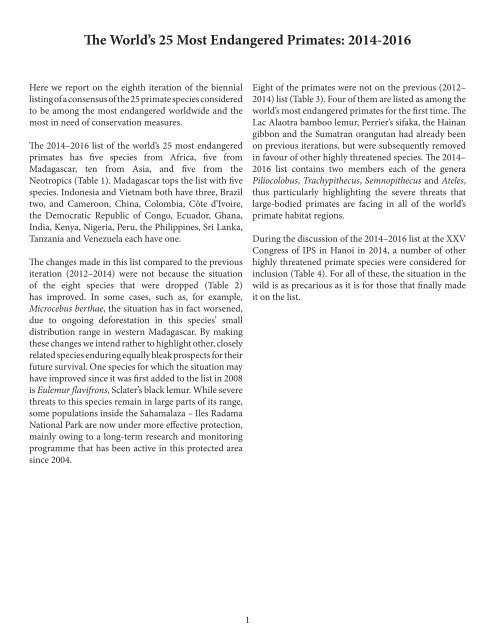Primates in Peril
f12q6x
f12q6x
Create successful ePaper yourself
Turn your PDF publications into a flip-book with our unique Google optimized e-Paper software.
The World’s 25 Most Endangered <strong>Primates</strong>: 2014-2016<br />
Here we report on the eighth iteration of the biennial<br />
list<strong>in</strong>g of a consensus of the 25 primate species considered<br />
to be among the most endangered worldwide and the<br />
most <strong>in</strong> need of conservation measures.<br />
The 2014–2016 list of the world’s 25 most endangered<br />
primates has five species from Africa, five from<br />
Madagascar, ten from Asia, and five from the<br />
Neotropics (Table 1). Madagascar tops the list with five<br />
species. Indonesia and Vietnam both have three, Brazil<br />
two, and Cameroon, Ch<strong>in</strong>a, Colombia, Côte d’Ivoire,<br />
the Democratic Republic of Congo, Ecuador, Ghana,<br />
India, Kenya, Nigeria, Peru, the Philipp<strong>in</strong>es, Sri Lanka,<br />
Tanzania and Venezuela each have one.<br />
The changes made <strong>in</strong> this list compared to the previous<br />
iteration (2012–2014) were not because the situation<br />
of the eight species that were dropped (Table 2)<br />
has improved. In some cases, such as, for example,<br />
Microcebus berthae, the situation has <strong>in</strong> fact worsened,<br />
due to ongo<strong>in</strong>g deforestation <strong>in</strong> this species’ small<br />
distribution range <strong>in</strong> western Madagascar. By mak<strong>in</strong>g<br />
these changes we <strong>in</strong>tend rather to highlight other, closely<br />
related species endur<strong>in</strong>g equally bleak prospects for their<br />
future survival. One species for which the situation may<br />
have improved s<strong>in</strong>ce it was first added to the list <strong>in</strong> 2008<br />
is Eulemur flavifrons, Sclater’s black lemur. While severe<br />
threats to this species rema<strong>in</strong> <strong>in</strong> large parts of its range,<br />
some populations <strong>in</strong>side the Sahamalaza – Iles Radama<br />
National Park are now under more effective protection,<br />
ma<strong>in</strong>ly ow<strong>in</strong>g to a long-term research and monitor<strong>in</strong>g<br />
programme that has been active <strong>in</strong> this protected area<br />
s<strong>in</strong>ce 2004.<br />
Eight of the primates were not on the previous (2012–<br />
2014) list (Table 3). Four of them are listed as among the<br />
world’s most endangered primates for the first time. The<br />
Lac Alaotra bamboo lemur, Perrier’s sifaka, the Ha<strong>in</strong>an<br />
gibbon and the Sumatran orangutan had already been<br />
on previous iterations, but were subsequently removed<br />
<strong>in</strong> favour of other highly threatened species. The 2014–<br />
2016 list conta<strong>in</strong>s two members each of the genera<br />
Piliocolobus, Trachypithecus, Semnopithecus and Ateles,<br />
thus particularly highlight<strong>in</strong>g the severe threats that<br />
large-bodied primates are fac<strong>in</strong>g <strong>in</strong> all of the world’s<br />
primate habitat regions.<br />
Dur<strong>in</strong>g the discussion of the 2014–2016 list at the XXV<br />
Congress of IPS <strong>in</strong> Hanoi <strong>in</strong> 2014, a number of other<br />
highly threatened primate species were considered for<br />
<strong>in</strong>clusion (Table 4). For all of these, the situation <strong>in</strong> the<br />
wild is as precarious as it is for those that f<strong>in</strong>ally made<br />
it on the list.<br />
1


